GE⊕-LPS Greater Earth Lunar Power Station
Arthur Woods, November, 2020
Abstract
The GE⊕ Lunar Power Station (GE⊕-LPS) is a multi-purpose concept that addresses several critical issues related to lunar development and terrestrial energy production. Briefly stated the GE⊕ Lunar Power Station is a habitable space station in lunar orbit that is also a solar power satellite. GE⊕-LPS will be constructed primarily from lunar resources and materials using lunar based automatized manufacturing processes. As such, GE⊕-LPS can provide needed electrical power for lunar based activities, serve as a gateway between Earth and Moon operations, provide artificial gravity for adaptive health purposes, serve as an attractive tourist destination and possibly become the basis for future space settlements in Geolunar space. Last, but not least, as the GE⊕-LPS concept and its energy production functions can be scaled to any dimension, larger versions could be positioned in Earth orbit and help provide much needed clean solar energy for terrestrial purposes. As such, the GE⊕-LPS unities the aims of lunar development while addressing the critical energy and environmental needs of human civilization on Earth.
Greater Earth and the GE⊕ Symbol

Diagram of Greater Earth
⊕ is the Greek astronomical symbol for planet Earth and is the symbolic form of the GE⊕ Lunar Power Station – a circle divided by a central cross. Greater Earth - GE⊕ - is a new perception of our planet that is based on Earth's true cosmic dimensions as defined by the laws of physics and celestial mechanics. Earth's gravitational influence extends 1.5 million kilometers in all directions from its center where it meets the gravitational influence of the Sun. This sphere, with a diameter of 3 million kilometers, has 13 million times the volume of the physical Earth and through it, passes some more than 55,000 times the amount of solar energy which is available on the surface of the planet. In addition to energy, within this sphere are other resources, including the Moon and occasional passing asteroids. Greater Earth is also understood to be an interdependent dynamic system involving the cosmic interactions of the Sun, the Moon and the Earth that has enabled life on Earth to emerge, to survive and to thrive. Awareness of Greater Earth and extending civilization throughout its regions may help catalyze an optimistic path to a sustainable and prosperous future for all humanity on Earth and beyond.
Space Tourism and Energy from Space
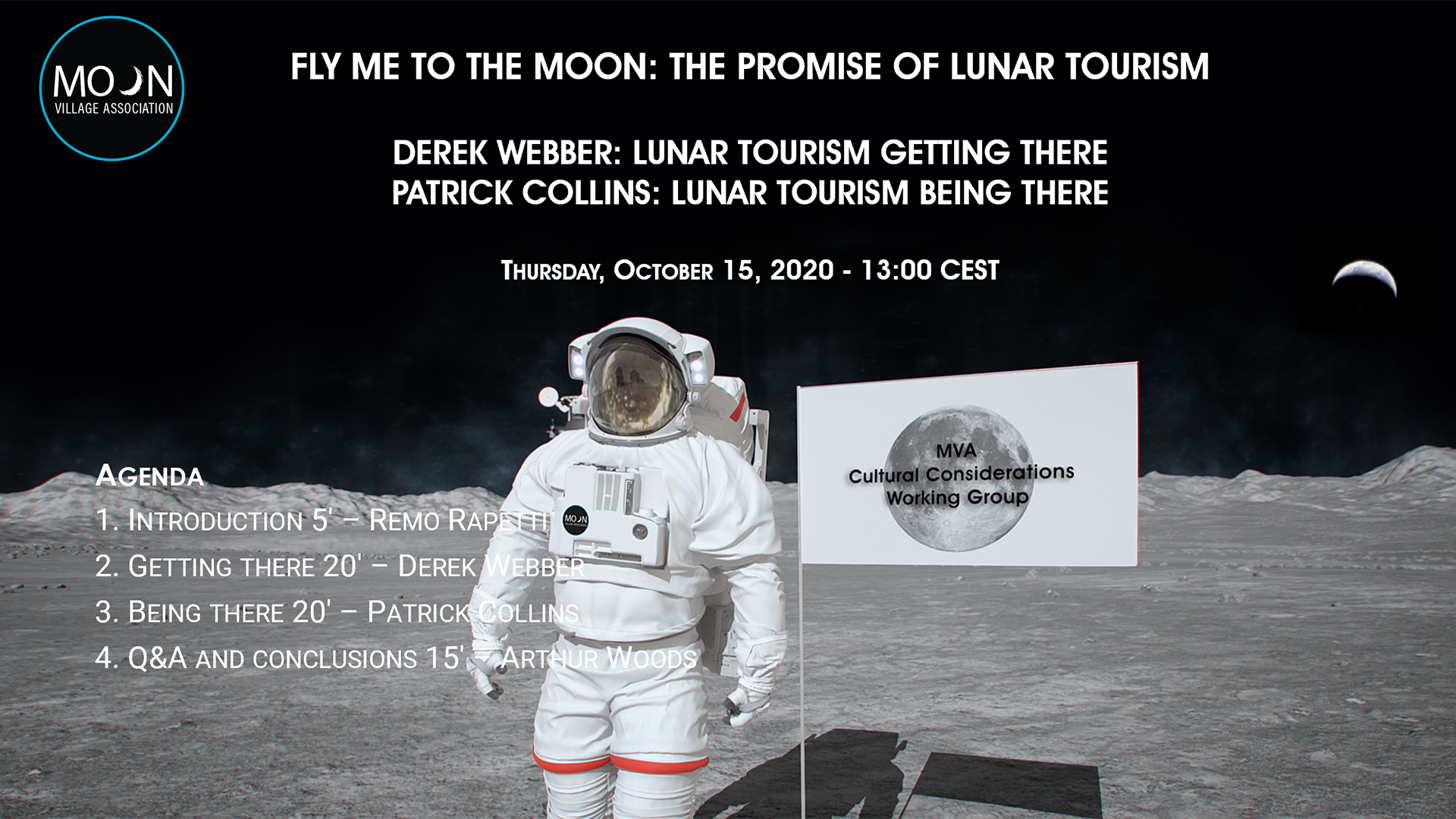
Moon Village Association Webinar: Fly Me to the Moon
For space development to be ultimately successful it needs powerful economic drivers. The potential of space tourism can be compared with the development of tourism on Earth. Since 1950, the evolution of air travel has now reached over 4 billion passengers a year and has created a major industry employing millions of people.
Space tourism was inaugurated with the first space tourists paying $20-30 million to visit the ISS. Sub-orbital tourism is poised to kick-off in 2021 with hundreds of passengers having paid $200,000 or more for a brief trip to the edge of space. Several private space operators are developing space tourist operations including high altitude balloon flights and orbital flights. Private flights to orbit the Moon have been offered at $150 million by Russian and American launch providers. Once these space tourism endeavors mature and new opportunities appear and the prices decrease, space tourism could follow the path of terrestrial tourism and become a major source of revenue for space development. Most importantly, the promise of space tourism connects space development with the widely shared fascination for space exploration among the general public.
Addressing Earth’s Energy Dilemma and the Climate Emergency
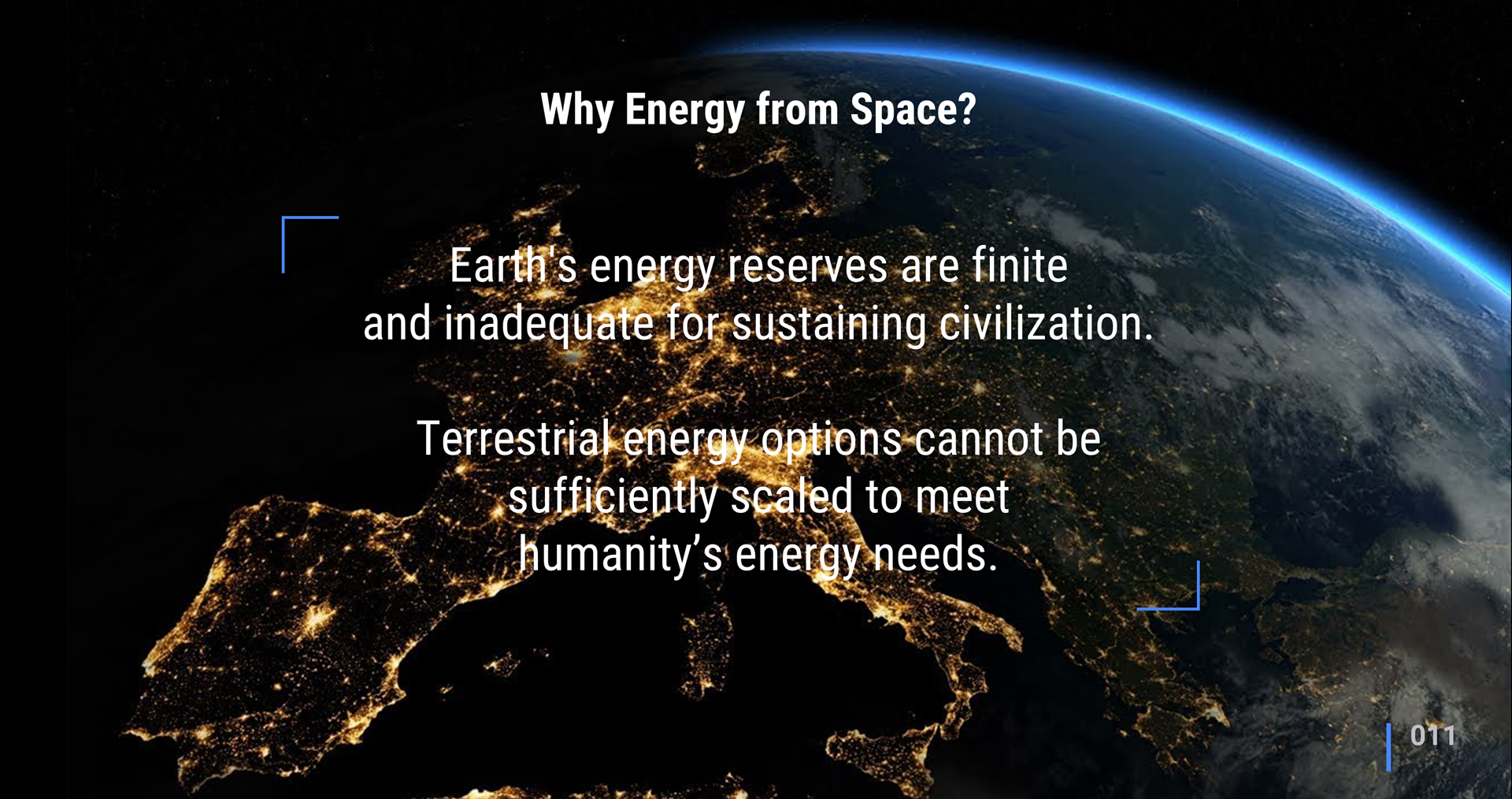
Among all of nature’s diverse systems, energy is the principal driver of the increasing complexity of galaxies, stars, planets and life-forms in the expanding universe. Energy flows engendered largely by the expanding cosmos seem to be as universal as anything yet found in nature. Indeed, unlocking Earth's vast energy reserves enabled our species to embark on an industrial revolution leading to a technological civilization that is on the threshold of expanding permanently into the near cosmos beginning with a permanent presence on Earth’s closest celestial neighbor – the Moon. However, Earth's terrestrial energy reserves are finite and inadequate for this next stage of a cultural and societal evolution which would enable humanity to become a spacefaring species. The largest market on Earth is for energy and, as such, supplying inexhaustible and clean energy from space to Earth could become the main economic driver for future space development.
Humanity is facing an imminent Energy Dilemma in that the limited proven reserves of fossil fuels could reach exhaustion levels at mid-century. In addition, none of the current alternative terrestrial energy options – nuclear – wind - ground solar (PV) – can be sufficiently scaled to achieve the goal of divesting from fossil fuels by the year 2050 as is being called for by the United Nations, the European Union and numerous organizations to address the Climate Emergency.
The BP Statistical Review of World Energy 2020 which lists World Primary Energy Consumption by fuel, i.e. oil, natural gas, coal, nuclear energy, hydroelectricity and renewables by region and by country is commonly used as a source for global energy data. [1] It reports that in 2019 total world energy consumption was 162,194 terawatt hours (TWh), of which 136,761 TWh (84.2%) came from fossil fuels, 10,461 TWh (6.5%) from hydroelectricity, 6,922 TWh (4.3%) from nuclear power and 8,050 TWh (5%) from renewables. The BP report listed these in totals in exajoules (EJ) which have been converted to TWh. Total energy consumption 2019: 583.90 EJ, Renewables: 28.98 EJ, Hydroelectricity: 37.66 EJ, Nuclear: 24.92 EJ, Coal: 157.86 EJ, Natural Gas: 141.45 EJ and Oil: 193.03 EJ. Combined fossil fuels coal, gas and oil = 492.34 EJ = 136,761 TWh.
Using nuclear power as an example, in order to replace current fossil fuel usage of 136,761 TWh with nuclear power (assuming a 90% availability) would require the deployment of up to 17,347 new 1-GW nuclear reactors. This means, for the next 30 years, 578 nuclear power plants would have to go online each year. Due to the long lead time to construct a nuclear power station and the lack of suitable locations providing sufficient cooling, nuclear power is highly improbable solution.
Concerning terrestrial renewable energy sources, the installed power generating capacity for wind power needs to be some 3.5 times higher and for solar PV, 6-7 times higher than nuclear power. Installing this much capacity also seems unlikely and, more importantly, both of these energy sources are intermittent and cannot be stored efficiently. Therefore, these two alternative energy sources are not adequate for meeting humanity's energy needs and climate goals. In his book on space solar power with the title Astroelectricity (2019) and on his Spacefaring Institute YouTube channel , Michael Snead's assessment of the U.S. energy needs in the year 2100 reached a similar conclusion concerning the lack of scalability of terrestrial energy alternatives [2].
As to economic considerations, using the BP report stating that in 2019 total world energy consumption was 162,194 TWh, it is possible to estimate the world energy market by using an average price per kWh US $0.13 as calculated by GlobalPetrtolRices.com, the value of the world energy market is approximately $ 21 trillion US dollars ($ 21,085,220,000.000). [3] The energy markets around the world are in a state of flux due to the pursuit of decarbonization and the search for viable terrestrial alternatives. However, as this market is the largest in the world, finding the most viable sustainable alternative is the ultimate economic opportunity and it will influence all areas of human activity.
Addressing this Energy Dilemma will require massive amounts of clean energy production for restoring the environment and meeting the energy needs of a growing population. Addressing the Climate Emergency will require massive amounts of clean energy production to adapt and survive a severe warming or cooling situation. Having sufficient clean energy would also allow our species to solve the water crisis, create new transportation fuels, reduce poverty, stimulate progress in the developing countries, sustain the world economy and to end conflict over finite energy resources.
The Space Energy Option in the form of Space-Based Solar Power (SBSP) is the only near term technically feasible and scalable energy alternative currently available to humanity to divest from fossil fuels while meeting its future energy needs and restoring the environment. The idea of harnessing energy in space originated with the Russian and Soviet rocket scientist and astronautical pioneer Konstantin Eduardovich Tsiolkovsky in 1926. In 1941, science fiction writer Isaac Asimov published the short story “Reason”, in which a space station transmits energy collected from the sun to various planets using microwave beams. The technical concept of delivering clean solar energy from space in the form of a Solar Power Satellite (SPS) was introduced by Peter Glaser in 1968 which he patented in 1973.
The Main Obstacle for Space-Based Solar Power
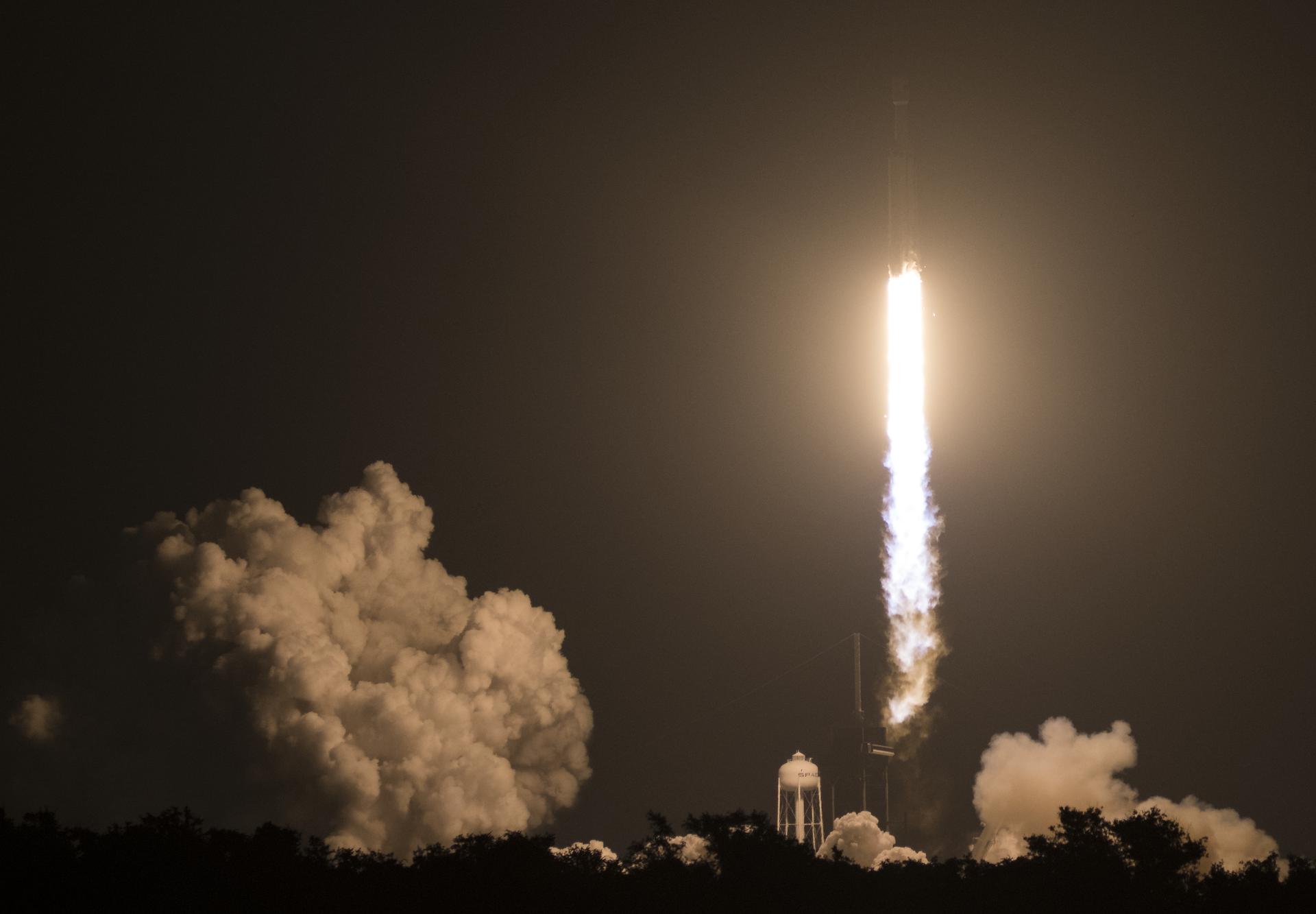
Falcon Heavy launch. Photo NASA
Since then, SBSP has been studied and researched for over fifty years. Although the engineering challenges are significant, all the core technologies already exist and have been tested. The main obstacle to implementing the Space Energy Option is launching a solar power satellite from the surface of Earth into orbit.
Former NASA physicist John Mankins has looked deeply into "The Case for Space Solar Power". [4] He led a study on space solar power at the International Academy of Astronautics [5] and has worked with NASA to develop the SPS-ALPHA concept which has now evolved into the SPS-ALPH MK-II version. The core element of his concept proposes that the photovoltaic (PV) power generation system would consist of an extremely large number of mass-produced modular PV elements that would robotically “self-assemble” into the SPS structure. This approach to assembling a SPS in orbit shows that the Energy Payback Time would be brief and that Space-Based Solar Power would quickly become profitable. [6]
Using his SPS-Alpha MK-II concept as a reference, a 1-GW solar power satellite would have a launch mass of approximately 5,000 MT (5,000,000 kg). SpaceX’s Falcon Heavy, the largest launch vehicle available today, can place 63.8 tonnes (63,800 kg) into low Earth orbit (LEO) at a list price of $90 million per launch or for $1.410/kg. [7] Thus, to launch a 1-GW SPS based on the ALPHA-SPS MK-ll design into LEO would require 78 Falcon Heavy launch vehicles costing approximately $7.1 billion. With an anticipated discount due to placing such a large order with SpaceX or another launch provider with equivalent capabilities, this amount could conceivably be reduced considerably. Estimating the manufacturing costs of the SPS to be $1 billion, and rectenna on Earth to cost $100 million, this puts the realization costs of launching a 1-GW SPS at $8.2 billion. Note this cost does not include the transfer from LEO to GEO which would require an Orbital Transfer Vehicle (OTV) using Solar Electrical Propulsion (SEP) directly from the SPS. Russia is currently developing a nuclear-powered space tug called Nuklon which could conceivably be used for the OTV. [8]
Is Space-Based Solar Power Economically Competitive?
Hypothetically, nuclear power plants could be replaced on a GW per GW basis by SPS as the capacity of both energy systems provide more-or-less the equivalent amount of electrical power. As comparison with the construction of a new nuclear power plant, there are two nuclear power plants in Western Europe currently under construction using a third generation EPR design (Evolutionary Power Reactor) which can be used as an actual reference.
Hinkley Point C nuclear power station – a 3.2 GW facility in Great Britain that is expected to eventually cost £22.5 billion ($29 billion). [9]
Flamanville in Manche, France begun in 2007 – 1.6 GW facility is now expected to eventually cost €12.4 billion ($14 billion) [10]
Hinkley Point C costs = $ 9.01 billion for 1-GW ($29 billion/3.2 = $9.0625 billion)
Flamanville costs = $8.75 billion for 1-GW ($14 billion/1.6 = $8.750 billion)
Using these examples, the average cost is approximately $9 billion per GW to construct a nuclear power plant today. This amount is based on what is referred to as the Engineering, Procurement and Construction costs or EPC. This does not include the cost of fuel, waste disposal, maintenance, nor decommissioning.
Regarding a SPS, the comparable EPC is for the construction and the launch of the SPS. The lifetime of the SPS structure once placed in orbit is essentially unlimited, although the solar modules will need to be serviced after 20-30 years. Due to their mass-produced modular design and robotic assembly in space, this should not significantly impact the operating costs when this maintenance becomes necessary. In contrast to nuclear power, there would be no recurring fuel, waste disposal or decommissioning costs.
This puts the realization costs of launching a 1-GW SPS from Earth in the price range of constructing a new 1-GW nuclear power plant. It would be more economical to launch larger solar power satellites with the capacity of 2-GW or even 5-GW. However, while this might make an interesting economic case, humanity’s enormous need for clean energy will require thousands of space power satellites with each GW of power capacity requiring at least 78 Falcon Heavy launches which would likely create undesirable environmental issues. Therefore, alternative approaches to realizing SBSP are needed.
In Situ Lunar Resource Utilization is the Solution
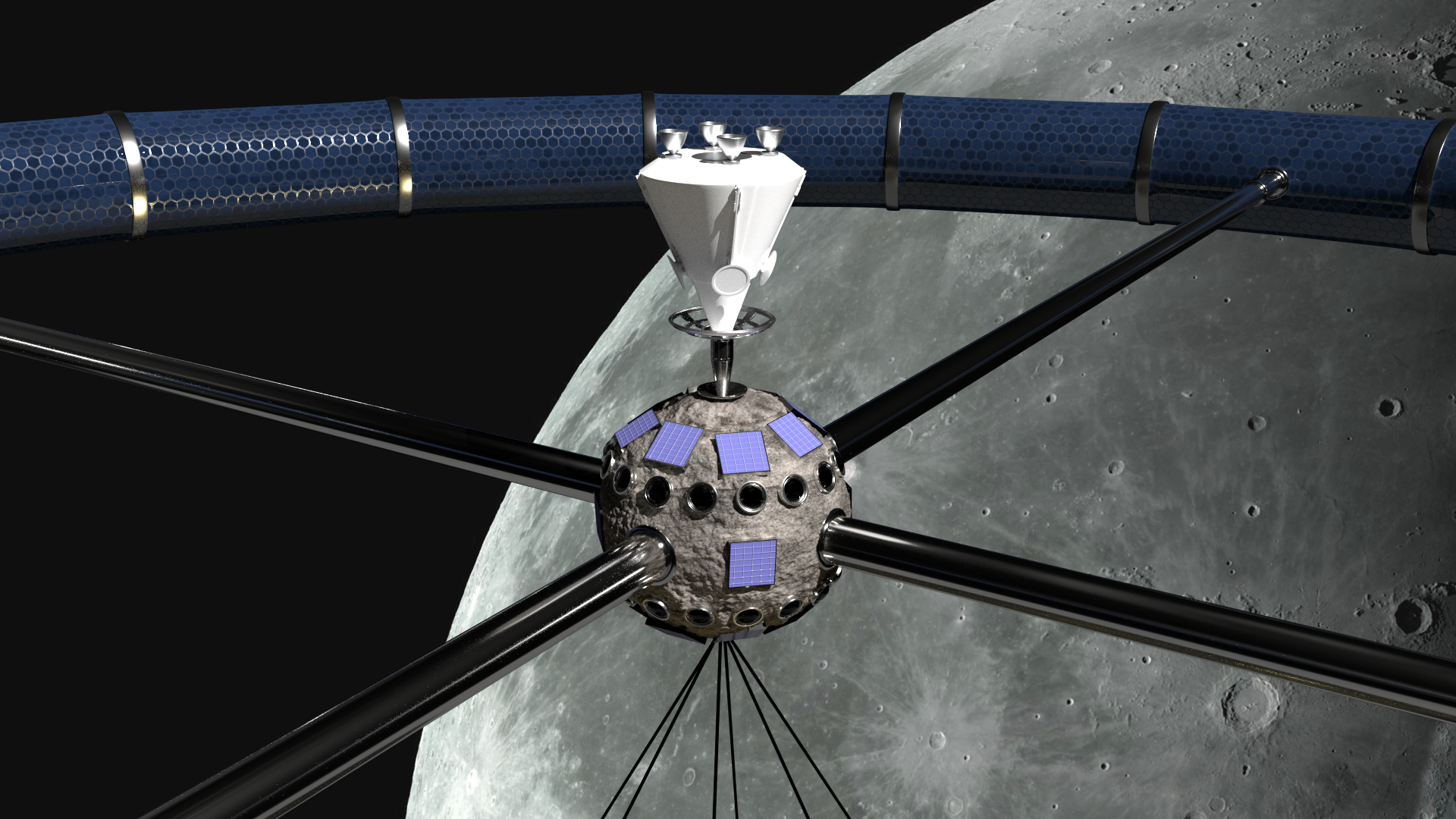
Lunar Lander Docked to the Station Habitat
In the mid-1980s, David Criswell introduced a significant variation of the SPS concept called the Lunar Solar Power (LSP) System.[11] Instead of building the photovoltaic system in Earth orbit using materials transported from Earth, he proposed a potentially more efficient approach by using an existing orbiting platform – the Moon – for the location of the solar collectors and to use lunar materials for their construction. The primary material necessary for the manufacture of photovoltaic (PV) collectors is silicon, which, as on Earth, is in great quantity on the Moon. The solar converters would be thin-filmed photovoltaics made from lunar glass which is created by heating lunar regolith to 2000 C. Robots will mine the lunar soil for silicon and other necessary materials and the photovoltaics would be manufactured in an automated factory constructed for this purpose. The vacuum environment of the Moon is ideal for applying the completed PV elements to the silicon substrate. Building upon the SPS-Alpha concept developed by NASA and John Mankins, Justin Lewis-Weber proposes that the photovoltaic power generation system would be constructed from an extremely larger number of small modular PV elements that would be manufactured in an automated factory on the Moon [12].


Assembly of the GE⊕-LPS in Lunar Orbit.
The finished PV elements would be sent into lunar orbit via an electromagnetic linear accelerator or a “Mass Driver” where they will be assembled into the toroidal elements of the GE⊕-LPS. The lunar mass driver concept was proposed in 1970s by American physicist Gerard O’Neill and his colleagues as a means of launching material from the lunar surface with the goal to build large orbital space colonies. A lunar mass driver several kilometers long should be able to deliver 600,000 tons a year to L-5, or more easily to L-2, at a reasonable cost. NASA has indicated the Moon’s L1 and L2 libration points would be the ideal location to receive to assemble large space structures [13]. The basic technology for mass producing manufacturing photovoltaics already exists and the engineering aspects of doing this on the Moon are typical of major construction and manufacturing techniques used on Earth. Thanks to Apollo, there exists substantial information about the lunar environment. Mass driver technology also has been researched and tested.
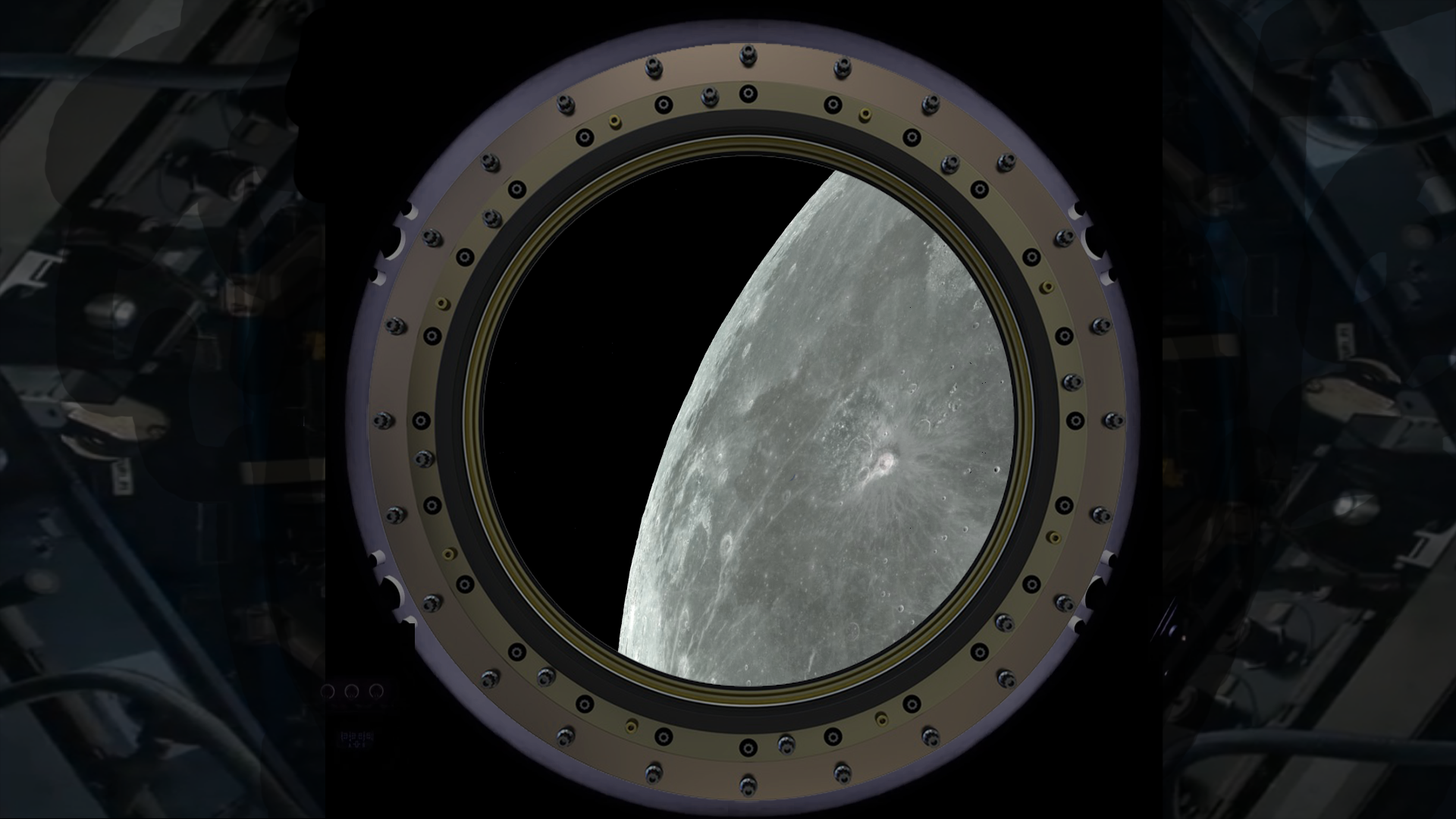
View of the Moon from inside the habitat.
Likewise, the central habitation module of the GE⊕-LPS would also be constructed in a modular manner and sent into orbit for assembly. First, using industrial 3D additive manufacturing techniques, a lightweight geometrical spherical structure – either an icosahedron or a geodesic polyhedron - would be built and sent into orbit. The outer surface of the habitat would be covered with matching interlocking elements made from “lunarcrete” produced in a lunar factory designed for this purpose [14]. Lunarcrete would be manufactured by beneficiating lunar rock that has a high calcium content. Water would either be supplied from sources on the Moon, or by combining oxygen with hydrogen produced from lunar soil [15]. When completed the outer surface of the habitat would consist of layers of “lunarcrete” modules which, together with an interior water barrier, also extracted from the Moon, would provide the necessary radiation shielding for the habitat. Once the initial structure was completed and sealed, interior components would be integrated. The habitat module would become the central basis of the GE⊕-LPS. Additive manufacturing methods would also apply to the construction of the four main spokes of the station. Making lunar glass by melting regolith can produce building materials of extreme strength and durability; anhydrous glass made from lunar soil would be stronger than alloy steel, with a fraction of its mass. Asteroid capture may be required to supply additional materials and minerals not found on the Moon [16].

Four ion thrusters using Solar Electrical Propulsion (SEP) for rotation, attitude control and maneuverability.
The individual segments of the outer torus will receive the photovoltaic modular elements which will automatically assembled into the pre-programmed system. These elements would be inter-locking and their electronics would be automatically integrated into the toroidal segment. As each toroidal segment is finished it will dock with the previously completed sections until the torus is completed.
Once the photovoltaic power elements are activated, the electrical power will be fed to the four ion electrical propulsion units positioned equidistantly along the torus. These moveable thrusters will maintain the precise rotational spin and attitude control of the GE⊕-LPS while also providing thrust for transferring the GE⊕-LPS to other orbital locations. As the Moon is within Earth’s Hill Sphere and the presence of mass concentrations or “mascons” below the lunar surface, lunar orbits are inherently unstable and constant orbital attitude adjustments will be required. The rotation will enable a centrifugal artificial gravitational environment for the habitat which will provide comfort and health attributes to the residents, workers and tourists by providing adaptation to either lunar-G or Earth-G environments.
Conclusion
Embracing the concept of Greater Earth as a new perception of our planet and understanding this as a dynamic system would be a viable strategy for merging the environmental and ecological movements with the economic goals and visions of the space community. Occupying the regions of Greater Earth including the Moon and Geolunar space is essential to the future of civilization.
Space tourism and energy from space could be the main drivers for future space development. Tourism connects space development to the dreams of spaceflight shared by much of the human population. Energy is the largest market on Earth with an annual value of $ 21 trillion. Harvesting inexhaustible energy in space and equally distributing it to all people of all nations would enable the entire population of Earth to have a prosperous and hopeful future. This is in contrast to current policies and measures being implemented to permanently downsize society in order that humanity may continue to live within the confines of a planet defined by the limits of its atmosphere. Utilizing lunar resources and lunar manufacturing facilities to build the solar power satellites would contribute to making SBSP more economically feasible and thus a reality for humanity.
Thus, the GE⊕ Lunar Power Station serves two critical and practical purposes: 1. it is a viable technical approach to realizing the Space Energy Option as a means to address the urgent energy dilemma and climate emergency issues on Earth, and, 2. it provides an inspiring and practical facility for developing humanity’s lunar aspirations. Indeed, humanity's future on Earth is irrevocably linked to its future on the Moon.
(*) Arthur R. Woods is an astronautical artist and independent researcher with two art projects successfully flown on the Russian Mir space station. He personally witnessed the beginnings of the US space program and worked at the Kennedy Space Center during the Apollo program. He is a member of the International Academy of Astronautics and co-chair of the Moon Village Association Cultural Considerations Working Group.
Click for References and Notes
